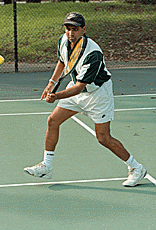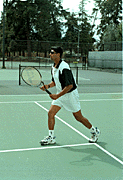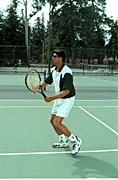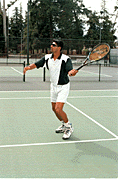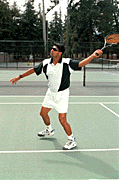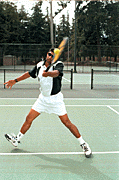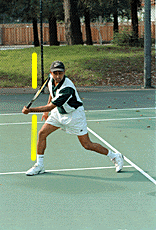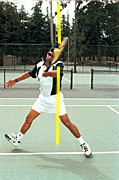|
TennisOne Lessons
Volleying the High Floater
QuestionIs there a way to hit a high floater with pace and control? I seem to hit them long or into the net. AnswerClick here to see animation of volleying the high floater. Hitting the high floater, while looking like an easy put-away, can be a nightmare-- especially if you're moving forward towards the net. The first problem with the high floater is the obvious one of no pace: you have to generate all the pace to make an effective shot. Secondly, the classic floater comes across at head height, making it too low for an overhead smash and too high to play it as a normal volley. To volley the high floater with pace and control, you must do two things: put spin on the ball and change your point of contact on the volley. Spin for Control
Point of Contact
Here, I have recognized that my opponent has sent a floater to my forehand. Notice how far my racquet goes back compared to a normal volley. On a normal volley, the racquet should not go back more than the shoulder of your playing hand. However, when hitting the high floater, the racquet goes back and past the shoulder, enabling you to develop more racquet head speed and drive the floater with more space. Note the racquet facing up towards the sky, indicating you're going to hit the ball with underspin, which adds control to your power shot.
Take note on the first frame how I am leading with the wrist and the bottom edge of the racquet (racquet tip slightly back) as I am swinging to make connection. In the last frame notice how my racquet finishes, slightly open. Which means I used a little bit of wrist to cup the ball and impart that slight underspin for a controlled winner.
However, the second frame is the most important frame of the lesson.
Remember the normal or the "ideal" volley? What were the two most important things I asked you to remember? Answer: spin and point of contact. Compare the two pictures. The point of contact when volleying the high floater is slightly back compared to the normal or the "ideal" volley. You can really see it by how my right leg actually steps ahead of the ball as I make connection. The height at which I should make the connection is slightly above my head. This ensures that I am catching the ball before it starts dipping below the net. Click here to see animation of volleying the high floater. Send email to the author We encourage you to email your comments (pro, con, appreciative,
whatever) directly to the author. To send email to Monty Basnyat, click here. Go To: Back to TennisONE Home Page webmaster@tennisone.com
|
